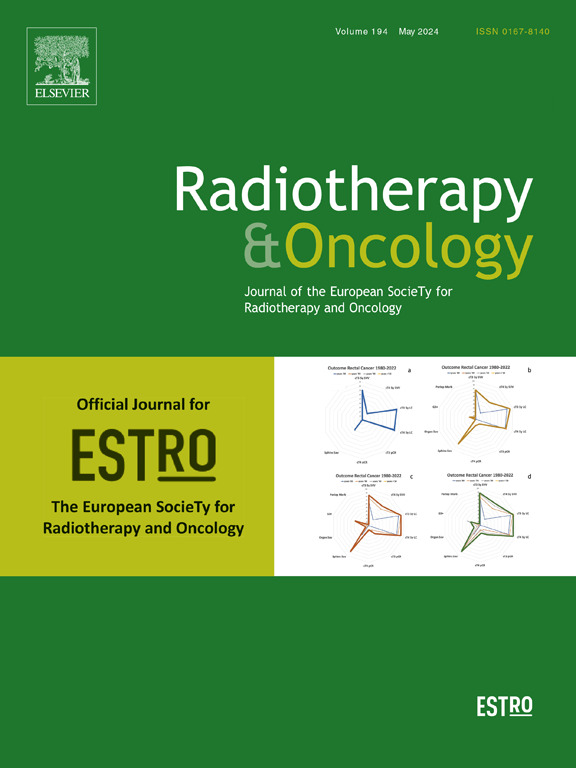利用弥散张量成像测量治疗对小儿后窝肿瘤幸存者记忆功能的影响。
IF 4.9
1区 医学
Q1 ONCOLOGY
引用次数: 0
摘要
背景和目的:本前瞻性探索研究的目的是利用弥散张量成像(DTI)研究治疗对小儿后窝肿瘤(PFT)幸存者大脑结构完整性和记忆功能的长期影响,以确定后者是否能提供有用的记忆损伤生物标志物:本研究将 60 名参与者分为三组:22 名接受过放射治疗的小儿脑窝肿瘤患者、17 名未接受过放射治疗的小儿脑窝肿瘤患者和 21 名健康对照组。所有参与者都接受了记忆测试和多模态磁共振成像,包括 DTI 序列。提取了与记忆有关的双侧大脑结构的平均扩散率和分数各向异性值,以便进行组间比较,并计算与记忆测试得分和放疗剂量的相关性。统计检验为双侧检验,P 值为 结果:接受过放射治疗的 PFT 幸存者的 DTI 指标明显高于未接受过放射治疗的 PFT 幸存者和对照组(p 结论:该研究的初步结果表明,微观脑干结构与记忆有关:本研究的初步结果表明,PFT 幸存者,尤其是接受过放射治疗的患者,记忆相关脑区的微观结构受损,并确定 DTI 指标为记忆缺失的潜在生物标志物。本文章由计算机程序翻译,如有差异,请以英文原文为准。
Measuring the impact of treatment on memory functions in pediatric posterior fossa tumor survivors using diffusion tensor imaging
Background and purpose
The aim of the present prospective exploratory study was to investigate the long-term impact of treatment on brain structure integrity and memory functions in pediatric posterior fossa tumor (PFT) survivors using diffusion tensor imaging (DTI), to determine whether the latter could provide useful biomarkers of memory impairment.
Material and Methods
Sixty participants were included in this study, divided into three groups: 22 irradiated PFT, 17 non-irradiated PFT, and 21 healthy controls. All underwent memory tests and multimodal MRI, including a DTI sequence. Mean diffusivity and fractional anisotropy values were extracted for bilateral brain structures involved in memory, in order to carry out between-group comparisons and calculate correlations with memory test scores and radiotherapy doses. Statistical tests were two-sided, and p values < 0.05 were considered statistically significant.
Results
DTI metrics were significantly higher for irradiated PFT survivors than in non-irradiated PFT survivors and controls (p < 0.05). Memory test scores were significantly lower for PFT survivors, particularly irradiated patients (p < 0.02), and were correlated with DTI metrics.
(−0.27 < r < -0.62, p < 0.04). DTI metrics were correlated with either total or maximum dose for some structures.
Conclusion
Preliminary results of this study point to microstructural damage in memory-related brain areas in PFT survivors, particularly in irradiated patients, and identify DTI metrics as potential biomarkers of memory deficit.
求助全文
通过发布文献求助,成功后即可免费获取论文全文。
去求助
来源期刊

Radiotherapy and Oncology
医学-核医学
CiteScore
10.30
自引率
10.50%
发文量
2445
审稿时长
45 days
期刊介绍:
Radiotherapy and Oncology publishes papers describing original research as well as review articles. It covers areas of interest relating to radiation oncology. This includes: clinical radiotherapy, combined modality treatment, translational studies, epidemiological outcomes, imaging, dosimetry, and radiation therapy planning, experimental work in radiobiology, chemobiology, hyperthermia and tumour biology, as well as data science in radiation oncology and physics aspects relevant to oncology.Papers on more general aspects of interest to the radiation oncologist including chemotherapy, surgery and immunology are also published.
 求助内容:
求助内容: 应助结果提醒方式:
应助结果提醒方式:


